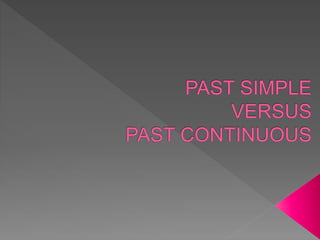Past simple versus past continuous
•Als PPTX, PDF herunterladen•
0 gefällt mir•21,367 views
Past Simple versus past continuous
Melden
Teilen
Melden
Teilen

Empfohlen
Empfohlen
Weitere ähnliche Inhalte
Was ist angesagt?
Was ist angesagt? (20)
Ähnlich wie Past simple versus past continuous
Ähnlich wie Past simple versus past continuous (20)
Mehr von lunanueva30
Mehr von lunanueva30 (19)
Kürzlich hochgeladen
Making communications land - Are they received and understood as intended? webinar
Thursday 2 May 2024
A joint webinar created by the APM Enabling Change and APM People Interest Networks, this is the third of our three part series on Making Communications Land.
presented by
Ian Cribbes, Director, IMC&T Ltd
@cribbesheet
The link to the write up page and resources of this webinar:
https://www.apm.org.uk/news/making-communications-land-are-they-received-and-understood-as-intended-webinar/
Content description:
How do we ensure that what we have communicated was received and understood as we intended and how do we course correct if it has not.Making communications land - Are they received and understood as intended? we...

Making communications land - Are they received and understood as intended? we...Association for Project Management
Kürzlich hochgeladen (20)
Food safety_Challenges food safety laboratories_.pdf

Food safety_Challenges food safety laboratories_.pdf
Fostering Friendships - Enhancing Social Bonds in the Classroom

Fostering Friendships - Enhancing Social Bonds in the Classroom
Sensory_Experience_and_Emotional_Resonance_in_Gabriel_Okaras_The_Piano_and_Th...

Sensory_Experience_and_Emotional_Resonance_in_Gabriel_Okaras_The_Piano_and_Th...
On National Teacher Day, meet the 2024-25 Kenan Fellows

On National Teacher Day, meet the 2024-25 Kenan Fellows
Beyond_Borders_Understanding_Anime_and_Manga_Fandom_A_Comprehensive_Audience_...

Beyond_Borders_Understanding_Anime_and_Manga_Fandom_A_Comprehensive_Audience_...
Kodo Millet PPT made by Ghanshyam bairwa college of Agriculture kumher bhara...

Kodo Millet PPT made by Ghanshyam bairwa college of Agriculture kumher bhara...
HMCS Max Bernays Pre-Deployment Brief (May 2024).pptx

HMCS Max Bernays Pre-Deployment Brief (May 2024).pptx
Making communications land - Are they received and understood as intended? we...

Making communications land - Are they received and understood as intended? we...
Past simple versus past continuous
- 2. We use it to talk about past and complete actions. There are two groups: regular and irregular. › The regular verbs add –ed. › Some of the irregular verbs. To go – went; To come – came; To swim – swam. › I went to the park but suddenly it started to rain. (Fui al parque pero de repente empezó a llover) › I was angry because they were late. (Estaba enfadado porque ellos llegaron tarde)
- 3. Spelling to add “ed” in the regular verbs We add –ed for most of them. › To miss – missed We add –ied when the verb ends in consonant + y. › To try – tried If the verb ends in vowel + consonant, it doubles the consonant when it has just one syllable, if the final syllable is stressed or it ends in –l: › Stop – stopped; prefer – preferred; travel – travelled
- 4. In negative and question sentences, we add the auxiliary “did”, except the verb to be. › We didn’t go to Norway last year. › Julia didn’t swim in her swimming-pool last weekend. › She wasn’t an actress when she was younger. Question and short answer: › Did you go? Yes, I did › Did she work? No, she didn’t › Were you at home? Yes, I was Adverbs or expressions which go with past simple: › Yesterday, two months ago, last year, last month… She danced yesterday night. She didn’t have dinner at home three nights ago.
- 5. We use it when we are in the middle of doing something at a certain time. The action or situation had already started before this time, but hadn’t finished. › It was raining when I left home. (Estaba lloviendo cuando salí de casa) › What were you doing at 10 last night? (¿Qué estabas haciendo a las 10 anoche?)
- 6. It is formed with the present of the verb “to be” and the gerund form of the main verb. In negative and question sentences, we add “not” to the verb to be. › We weren’t going to the gym when I saw you. › Julia wasn’t swimming in her swimming-pool when she fainted. Question and short answer: › Were you going? Yes, I was › Was she going? No, she wasn’t
- 7. We use both to say that something happened in the middle of something else. › Matt phoned while we were having dinner. (Matt llamó por teléfono mientras estábamos cenando). › It was raining when I got up. (Estaba lloviendo cuando me levanté) We use the past simple to say that one thing happened after another. › I was walking along the road when I saw Dave. So I stopped, and we had a chat. (Estaba caminando por la carretera cuando vi a Dave. Así que paré, y charlamos) We use the past continuous to say that two actions happened at the same time. › I was reading a book while Peter was watching TV. (Yo estaba leyendo un libro mientras Peter estaba viendo la TV)
- 8. http://www.youtube.com/watch?v=avz_K3FJ hKY&hd=1 (Past simple versus past continous) http://www.youtube.com/watch?v=LJ4lcdadg vA&hd=1 (Past simple) http://www.youtube.com/watch?v=t9t4rt7M6 wU&hd=1 (Past simple versus past continuous cartoon)